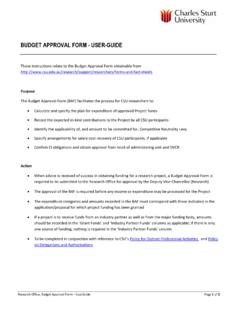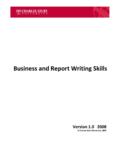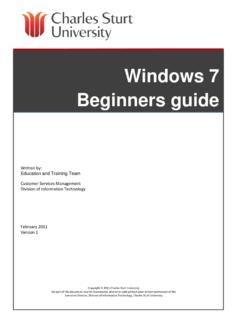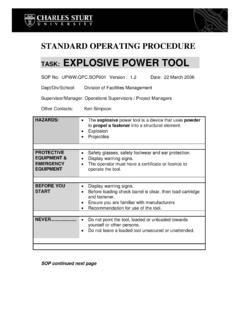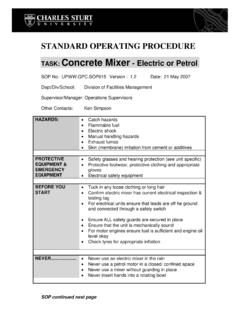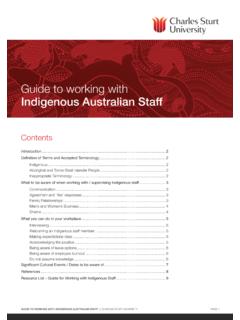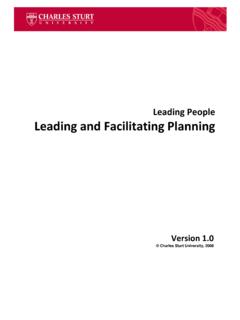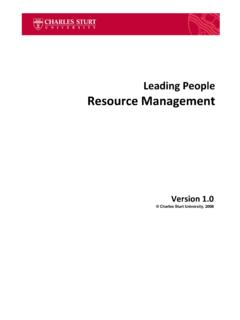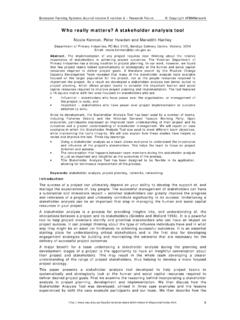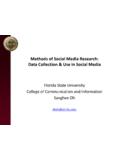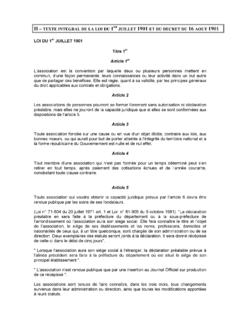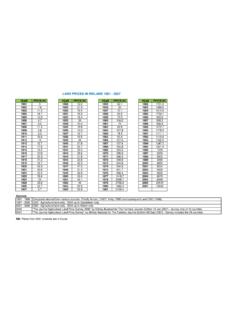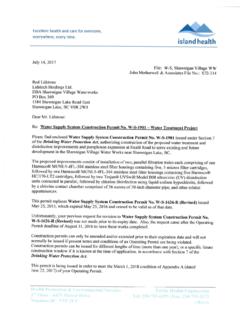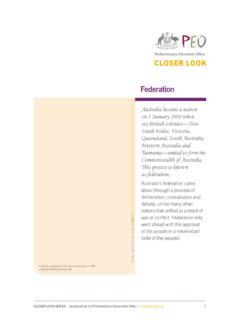Transcription of A GAZETTEER OF NEWSPAPERS FROM THE CENTRAL …
1 The Johnstone Centre Report N 198. A GAZETTEER OF NEWSPAPERS . FROM THE CENTRAL victorian . goldfields (1851-1901). by Sue Hughes Albury 2003. Sue Hughes All rights reserved. The contents of this book are copyright in all countries subscribing to the Berne Convention. No parts of this book may be reproduced or transmitted in any form or by any means, electronic or mechanical, including photocopying, recording or by any information storage and retrieval system, without the written permission of the author, except where permitted by law. Hughes, Sue A GAZETTEER of NEWSPAPERS from the CENTRAL victorian goldfields (1851-1901). / by Sue Hughes Johnstone Centre Report no 198. Albury, : The Johnstone Centre, Charles Sturt University 1v.;. ISBN 1 86467 147 5. GAZETTEER of NEWSPAPERS from the CENTRAL victorian goldfields (1851-1901). Contents 1. INTRODUCTION ..1. 2. METHODOLOGY ..3. Sources of The archival record ..4. Secondary 3. RESULTS ..6. The GAZETTEER ..7. 4. APPENDIX 1: PRESS SITE GAZETTEER (1851-1901).
2 18. Figure Figure 1 Map of press sites in CENTRAL Victoria in relation to gold mining districts..2. Figure 2 Number of newspaper titles launched (or attempted)..7. i Acknowledgements This project was made possible by the generous assistance and support of my academic supervisors, Dirk Spennemann and Ross Harvey. To Rod Kirkpatrick, I. convey my sincerest thanks for the many hours spent responding to my queries. I also wish to record my appreciation for the assistance of Dr. Richmond at the University of Melbourne Archives for alerting me to the uncatalogued index cards of Frank Strahan. For help with digitising the 1869 map I am indebted to Ricardo and Jackie Simao. Finally, I thank my friends and family for their wonderful moral support and patience. All failings in the execution of this work are, naturally, my own. Abbreviations NAA National Archives of Australia NLA National Library of Australia SLV State Library of Victoria VLA Victoria Legislative Assembly VPM victorian Press Manual GAZETTEER of NEWSPAPERS from the CENTRAL victorian goldfields (1851-1901).
3 1. INTRODUCTION. Few events in history have changed the shape of society so profoundly as the discovery of gold in CENTRAL Victoria in 1851 (Morton 2001). Coinciding with self-governance, the sudden increase in population and the wealth generated by gold transformed the Port Phillip district from a pastoral outpost into a dynamic colony (Bate 2001; Serle 1977). The colonial press played a pivotal role in this rapidly changing social, economic and political environment (Cryle 1992;. Morrison 1991). The press was not only the overriding mechanism for influencing events and forming public opinion, it was an active force, vital to creating communities and a distinct national identity (Kirkpatrick 2000; Kwasitsu 1989; Morrison 1980). While Victorians are heirs to a vivid legacy of cultural resources from the goldrush era, little attempt has been made to identify, document, protect or interpret the heritage of colonial newspaper production (Butcher & Flanders 1987; McCalman, Cook & Reeves 2001; Morrison 1991).
4 As nineteenth century NEWSPAPERS chronicled Victoria's history, on a weekly or more frequent basis, scholars from a variety of disciplines value the printed contents of colonial NEWSPAPERS as rich sources of information (Cryle 1998; Hunter 2002; Moore 2000; Picker 1994). However, the dependence on NEWSPAPERS , as a source of record, has had such a dominant place in our historical traditions that places, historic structures and artefacts have been much neglected as historical source material' (Australian Heritage Commission 1985, ). Despite Inglis' (1974) contention that after the gold ran out, commercial activity became the mainstay of victorian goldfield towns, regional heritage studies in CENTRAL Victoria are generally confined to assessments of churches, cemeteries, private homes, gardens and public buildings (Davison & McConville 1991; Pearson & Sullivan 1995). Mining sites, flour mills, eucalyptus distilleries and saw mills, brick and gas works, water supplies, powder magazines, railway lines and stations are among the major industries that preoccupy historical and industrial archaeologists (Birmingham, Jack & Jeans 1983; Lamborn 1998).
5 The opportunity to locate and document the places associated with other town services, such as newspaper production, has not been fully realised. As a result, the historic structures of the goldfields ' press are under- represented on victorian heritage registers. This failure is not confined to the press; it encompasses all forms of commercial activity (Blake 1989). The obvious difficulty with this approach is that our cultural resources are scarce, finite, irreplaceable and valuable (Spennemann 1998). In a climate of frequently conflicting interests of economic development and historic conservation the tangible evidence of nineteenth century newspaper production, that is not formally protected, may continue to disappear from the landscape and be lost to us forever. The loss of heritage is irrevocable; it diminishes us all, and severs the links from our past to the next generation (Tiller 1997). Despite finding that 198 NEWSPAPERS were published (or attempted) in CENTRAL Victoria prior to 1901, only the Rushworth Chronicle office is currently afforded protection under heritage legislation.
6 In an attempt to compensate for the bias in heritage preservation in the region, this exploratory study is limited to the first stage of cultural resource management: the gathering and recording of documentary evidence, (Spennemann 1998). The results suggest that the nineteenth century newspaper industry in CENTRAL Victoria was widespread, diverse and significant. 1. GAZETTEER of NEWSPAPERS from the CENTRAL victorian goldfields (1851-1901). Decade Press Site Established 1850s 1860s 1870s 1880s 1890s Gold mining district Figure 1 Map of press sites in CENTRAL Victoria in relation to gold mining districts (1851-1901). The spread of production is indicated by the decade in which the press site became active and the number of titles established (or attempted). Adapted from Smyth 1869. 2. GAZETTEER of NEWSPAPERS from the CENTRAL victorian goldfields (1851-1901). 2. METHODOLOGY. Defining the parameters of chronology for this study was relatively easy. The first newspaper attempted (but not published) in the CENTRAL goldfields was the Prospector and Buninyong Mining Gazette in 1851, which followed shortly after the discovery of gold and the separation of the colony from New South Wales (Harrison 1851; Kirkpatrick 2003a).
7 Federation in 1901 was the logical end as it marked fifty years of growth and development. As Morrison (1991, ). suggests, the turn of the century was a time when NEWSPAPERS and colonists were setting their sights on the making of a federated Australia'. Geographically the problem was far more complex. The CENTRAL victorian goldfields lie north-west of Melbourne and cover nine local government shires. So how much of the region should be included? Tourist maps that promote the goldfields vary in accordance with their target audience. Whereas gold fossicking maps are limited to particular sites, heritage trails focus on the core tourist areas of Ballarat, Bendigo and Castlemaine and often omit outlying towns such as Heathcote, Ararat and Rushworth (see for example Finders 2003; goldfields of Victoria Marketing Committee 2001 and Jardine 2003). Even though Smyth's map of gold mining districts dates from 1869 (and so fails to show areas where the gold had been previously exhausted, or as yet undiscovered), it forms a reasonably coherent and appropriate geographical unit.
8 The map determined a study area bounded by Murchison in the east, Stawell in the west, Rokewood in the south and Wedderburn in the north (Figure 1). The next challenge was to determine the extent of newspaper production in the geographical unit. Defining the goldfields within this arbitrary boundary necessitated omitting NEWSPAPERS on the periphery, even those with titles that indicated they circulated in the region, or those circulating on the goldfields but printed elsewhere. For example, in 1879 the Freelance and East Charlton, Wedderburn and Lower Avoca and North Western Chronicle was published from a press site in High Street, East Charlton, 18 kilometres north of the boundary (Darragh 1997, ). Likewise the Diggers Advocate is claimed by Kimberly (1895), Kirkpatrick (2003b), Mackay (1891), Serle (1977) and others, to be the first goldfields paper. The paper was distributed on the goldfields from 3 November 1853 to September 1854, but was only ever printed in Melbourne. In addition, the extension of railway networks allowed printers to publish papers in one locality and distribute them in another.
9 For instance in 1884 the Bendigo Bulletin was printed in Ballarat, and in 1890 the Trentham Advertiser was published at Howe Street, Daylesford (Darragh 1997, , 245). Even when the press site can be verified, identifying an individual paper in the literature is often challenging. Most commentators adopt short (or uniform) titles: long titles tend to interrupt narrative flow. Scholars can be excused for abbreviating The Times and General Mining, Mercantile and Law Reporter for Geelong, Ballarat, Creswick, Buninyong, Avoca and all the Western District to simply the Times. The task of identification was also complicated by other difficulties of a more general nature, such as amalgamations, frequent title and ownership changes. Equally, drawing the line between NEWSPAPERS and monthly publications is problematic when tracing the extent of publication in colonial Victoria (Morrison 1991; Stuart 1979). Since the beginning of printing, governments have sought to regulate the press, either directly or indirectly (Darragh 1997; Mayer 1964; Walker 1976).
10 During the seventeenth century, regulation of the press in England became the prerogative of the British government (Hunt 1850). Printing was restrained by patents, monopolies, censorship, libel actions, and the imposition of stamp and advertising duties (Bonwick 1890; Lloyd 1999). British impositions 3. GAZETTEER of NEWSPAPERS from the CENTRAL victorian goldfields (1851-1901). were still in place when printing began in the Australian colonies. By 1827, New South Wales had provided an administrative model that required all NEWSPAPERS to be registered (Cannon &. Macfarlane 1985; Darragh 1997). newspaper publishers in Victoria were subject to these laws until the Printers and newspaper Registration Statute 1864 (Vic) was passed and NEWSPAPERS were defined as: every paper or any public news or occurrence or any remarks or observations thereon or upon any political matter and published for sale periodically in parts or numbers at intervals not exceeding twenty-six a price of sixpence or less.
